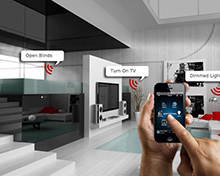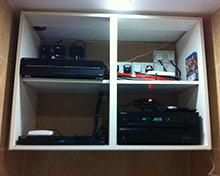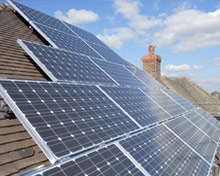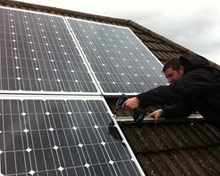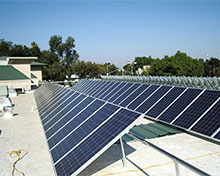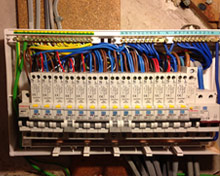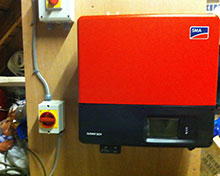Solar Panel (PV) Installations

Solar Panels (PV) Installations available from 1.5KW - 4.0 KW for you to generate Electricity to power your home, written quotation available on request.
A solar PV system works using a number panels (an array), which is normally mounted on the roof. Each solar panel is made up of photovoltaic cells. These are usually made of wafer-thin layers of silicon and look a bit like blue or black tiles. When daylight hits the cells it creates an electric field. The brighter the sunlight, the more electricity is produced. This direct-current (DC) electricity then flows to an inverter, which converts it into alternating-current (AC) electricity for you to use.
If you have a solar PV system installed at home, it will automatically feed the power you’ve generated to your appliances, so a lot of the power you use during the day will be free. During the night times, or if you use more energy than you produce, your power supply will switch back to the grid. You won’t notice any disruption or change – just smaller bills.
To make the most of all that free electricity, it’s best to use appliances like dishwashers and washing machines during the day. The system can’t store electricity, so if you produce more than you use during the day, any excess will be fed into the national grid for others to use.
Solar PV is a great investment for the future. Not only will it help you save on energy bills and protect you against rising fuel prices, it will also generate a tax-free income through the government’s feed-in tariff payments. Under the government’s feed-in tariff (FIT) scheme, you’ll be paid for every unit of electricity you generate, whether you use it or not.
Since the scheme was introduced in 2010 it’s encouraged thousands of UK homeowners to install PV panels. And as well as securing strong financial returns through the tariff, you’ll also enjoy lower energy bills, protect your home from rising fuel prices and lower your impact on the environment. It all makes solar PV the ultimate feel-good investment.
How it works
The feed-in tariff is guaranteed by the government for 20 years. Payments are tax free (as long as you live in the property rather than rent it out) and will also increase in line with inflation. If you have a solar PV system installed at home, you’ll benefit in three ways:
You’ll get paid for all the electricity you produce
This is called the generation tariff. Your electricity supplier will pay you the current FIT rates for every unit of electricity your system generates, whether you use it in your home or not. Currently the rate for small home installations (below 4 kWp) is 15.44p for every unit (or kWh) you generate.
You’ll get an extra payment for the electricity you don’t use
Also known as the export tariff. You probably won’t use all the energy you generate, so what’s left over will be exported into the grid. Your electricity provider will pay you an extra 4.5p for every unit. Most suppliers can’t meter this, so they assume you’ll use half the units you produce and pay you for the rest.
You’ll reduce your energy bills
Electricity generated by your solar panels will feed directly into your house, so it will power any appliances you’re using during daylight hours. As electricity prices continue to rise, this is a huge benefit for our customers. Lots of our customers save more by changing small habits, such as using the washing machine and dishwasher during the day instead of the evening.
Example
Generation Tariff + Export Tariff + Bill Savings = Annual Benefit
A well-designed 2.88kWp system will receive feed-in tariff (generation and export tariff) payments of £435 a year, and save £177 a year on
electricity bills.
If the system costs £6,254 to install, it gets a return on investment of 9.78%. That’s before you take predicted energy price rises into account.
With returns like that, it’s no surprise many people are choosing to install solar PV systems as an alternative to investing their money with a bank or
building society.
Eligible systems
To claim the tariff, your system needs to meet a few simple criteria:
- Your installer must be accredited with the Microgeneration Certification Scheme (MCS).
- Your panels must also be MCS approved, and must be new – second-hand or reconditioned equipment isn’t eligible.
- Your system size must be less than 4kWp to qualify for the highest tariff rate. Most domestic systems are well within this limit.
- Your energy supplier must offer FIT payments. The big six suppliers – British Gas, EDF, E.ON, Npower, ScottishPower or Scottish & Southern Energy – are legally obliged to make payments, and many (though not all) smaller suppliers have opted in to the scheme
- Since 1 April 2012, homes must also meet minimum energy efficiency standards to claim the full tariff. This is explained in more detail below.
Energy performance certificates
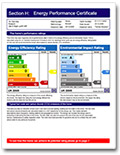
- From 1 April 2012, only homes that have an energy performance certificate (EPC) at grade D or above will receive the full feed-in tariff
- EPCs give homeowners a snapshot of how energy efficient their home is. It shows how your home ranks on a chart of seven coloured bands, ranging from A (the most efficient, in dark green) to G (the worst, in red).
Registering for FITs
- Registering for payments is simple. First we’ll add you to the central MCS database, then send you a certificate confirming your system complies with MCS standards. Next, you’ll need to tell your electricity supplier you’d like to register for the FIT and send them a completed application form along with your MCS certificate and the energy performance certificate. Don’t worry, we’ll help with all the paperwork.
- Your electricity supplier will check your installation against the MCS database, confirm that the system’s eligible and add you to the Ofgem Central FIT Register. They’ll also let you know when they need you to give meter readings, and tell you when to expect payment.
NICEIC Approved Contractor
NICEIC has been assessing the technical competence of electricians for over 50 years. Our aim is to protect everyone who uses
electricity from unsafe electrical installations in their homes, places of work and elsewhere. To achieve this, we maintain a register of qualified, competent
electricians.
We look at a representative sample of the contractor’s work, their premises, documentation, equipment, and the competence of their key supervisory staff.
Once contractors become registered with NICEIC, they are re-assessed on a regular basis to ensure high standards.
Visit the NICEIC website for more information.
Latest Projects
Some of the electrical installations we have undertaken recently.
To view more, please see our photo gallery section.

